|
ANIAKCHAK
Beyond the Moon Crater Myth A New History of the Aniakchak Landscape A Historic Resource Study for Aniakchak National Monument and Preserve |

|
HUBBARD'S EXPLORATION (1930-1932)
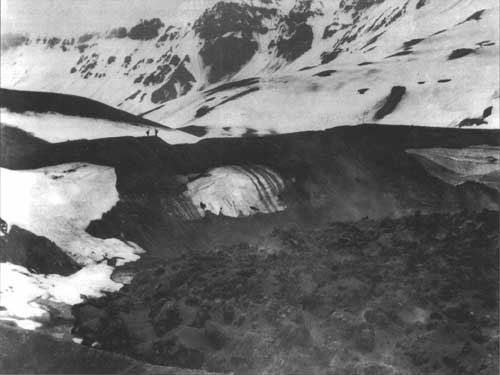
|
| Site of 1931 eruption, 1932, Bernard Hubbard, S.J. Alaskan Photograph Collection. Photograph courtesy of Santa Clara University Archives. ACK-35-262. |
CHAPTER EIGHT
Exploring the Moon Crater of Alaska:
From Foot to Flight
Oh, Father Hubbard. I remember that one plane would come around and. . . we would say, "Look there's a plane," my aunty... or my dad would say, "oh, that's Father Hubbard." We didn't know who Father Hubbard was; we just see the plane flying around.
Christine Martin, resident of Chignik Lake
Father Hubbard's Aniakchak drama unfolded in the early 1930s when he and his team of collegiate explorers made three famous visits to the central Alaska Peninsula. The first came in 1930 when Hubbard and his students spent two weeks in June exploring what they called a "geological wonder world." The second visit followed Aniakchak's timely eruption on May 1, 1931. For two months that summer, the team explored a world that contrasted greatly with the world they had observed the previous year. Then in 1932, on his third trip to Aniakchak, Hubbard and pilot Frank Dorbandt made a historic first landing of a floatplane on Surprise Lake.
The 1931 eruption of Aniakchak received scant attention in local and national press. As historian Frank Norris notes, "The eruption would doubtless have slipped into ignominy had it not been for the efforts of Father Bernard R. Hubbard." [1] While exploring the Aniakchak Caldera. Hubbard concerned himself more with scaling and filming the active cinder cones inside the crater than conducting scientific experiments. By the late 1930s, when Hubbard was making the lecture circuit rounds, the press began to cover his previous adventures in Aniakchak, praising the Glacier Priest for his daring achievements there. His actual contribution to science, although mentioned time and time again in popular books, articles, and films, rarely appeared in the scientific literature itself. In fact, controversy over Hubbard's claims and the true level of his expertise pursued him for much of his career. [2]
As Hubbard's Glacier Priest became increasingly popular on the lecture circuit, stories of his exciting feats became littered with falsities. The American Catholic, for instance, noted that Hubbard's party was the first to scale Aniakchak. [3] Likewise, the New York Times declared, "Father Hubbard Tells of Trips of Exploration of Huge Bowls Never Before Invaded by Man." [4] In his best-selling book, Mush, You Malamutes!, Hubbard explained why people chose not to live in the Aniakchak region: "Native and white men [Russians] alike avoided the forbidding interior with an almost suppositious dread." [5]
Although the Glacier Priest suggests that his team represented the first "white people" to have ascended into the crater and claims that Aniakchak was "a place nobody knows" in the popular accounts, the historical record shows that both professional and armchair explorers knew about the central Alaska Peninsula for at least a full century before Hubbard visited the crater. During the Russian Period, we know that at least one Russian explorer visited Aniakchak Bay and had spoken to local residents. Von Krusenstern's atlas, published in 1827, noted both "Baie Amah-chack" (Aniakchak Bay) and "C [ap] Koumlick" (Cape Kumlik). [6] Shortly thereafter, Russian surveyors entered the bay. From 1831 to 1832, Ensign Vasiliev of the Imperial Russian Navy mapped the Pacific Coast from Cook Inlet to Cape Kumliun. The results of his work were published in 1836. His survey work was corroborated in the 1840s by the expeditions of Lindenberg and Kashevarov. By 1850, most of the prominent coastal place names, including Kujulik Bay and Amber Bay, had already been recorded. [7] Moreover, by 1895, Russian Orthodox priests knew Aniakchak was a volcano, for that year Father Kedrovskii, while describing his voyage down the western side of the peninsula, noted that "Between Ugashek and Inangashek is Mashkhik [Meshik] Bay, located at the foot of an extinct volcano." [8] That "extinct" volcano was undoubtedly Aniakchak.
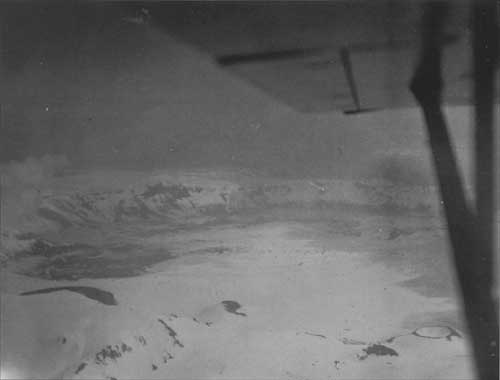
|
| Aerial view to northeast over Birthday Pass, the 1931 cone is at the lower left, ca. 1931. Bernard Hubbard, S.J., Alaskan Photograph Collection. Photograph courtesy of Santa Clara University Archives. ACK-00-1 67. |
American trappers and fishermen were also aware of Aniakchak long before Father Hubbard explored the region. It was well known that local trappers—both Native and non-Native—traversed the land surrounding the crater as they hunted for the region's fur-bearing animals. The Alaska Commercial Company operated at least one trading post at Sutkhum, and by 1917, the commercial fishing industry had established the first fish traps in Aniakchak Bay. Despite Hubbard's claims, the scientific community knew of Aniakchak as early as 1919. The famed Katmai explorer, Robert F. Griggs, identified the Caldera and called the formation the "old Crater." Then, in 1921, oil prospector W.W. French actually entered the Caldera. However, it was not until 1922 that the Aniakchak Caldera was officially placed on the map by USGS surveyors. That summer, a party of six men headed by R.H. Sargent, a topographer, and Walter R. Smith, a geologist, surveyed the eastern portion of the peninsula from Kanatak southwest to Chignik, looking for commercial-size oil deposits. Three years later, another six-man party, headed by Sargent and geologist Russell Knappen, surveyed both sides of the peninsula from Mr. Chiginagak southwest to Mt. Veniaminof. Sargent and Smith's expedition found no oil, but it did report the discovery of a large "extinct" volcano," the Aniakchak Caldera, located midway between the Bristol Bay and Pacific coast. By 1930, then, Aniakchak had been well known by corporate, federal, and international interests for several decades.
* * *
Father Hubbard, as his famous moniker "the Glacier Priest" implies, first came to Alaska to study glaciers. His initial field explorations concentrated on the Juneau Icefield, but a visit in 1929 to the Valley of Ten Thousand Smokes in the Katmai region shifted his intellectual interest. The "terrible grandeur" of the devastated landscape intrigued the priest to such a degree that his research activities for the next several years were dedicated to the volcanoes of the Alaska Peninsula. [9] As Hubbard explained in 1930, "I saw the Valley of the Smokes and Katmai's crater last year. I was convinced Alaska had nothing further in the way of surprises to offer. But on my return from that trip I learned of the Moon Craters." [10]
By a stroke of luck, Father Hubbard's timely visits to the central Alaska Peninsula in 1930 and 1931 documented Aniakchak "before and after" a relatively small eruption occurred during the late spring of 1931. Hubbard, with typical flair for the dramatic, labeled the eruptive landscapes "Paradise Found" and "Paradise Lost." According to scientists, Hubbard's fortuitous findings—especially the photographs he took of them—are his most significant contribution to science, for the photos document life in the crater before and after the eruption and provide an important benchmark by which to judge the rate at which vegetation and wildlife would return to the devastated Caldera. [11]
Although such data remains significant to modern scientists, in 1931 Aniakchak had made the Glacier Priest genuinely famous for far different reasons. An article that appeared in American Magazine in 1935 declared, "Father Bernard Hubbard is the world's most daring explorer: [He is] the first man to paddle a canoe in a lake in the fiery pit of Mt. Katmai in Alaska. He has singed his whiskers flying in a plane over boiling lava beds. [He even] Took the first pictures inside a volcano." [12] Similarly, Current Biography noted in 1943 that Hubbard was a true celebrity because the Glacier Priest "flew over Aniakchak, the Alaskan 'moon crater,' which had been giving the greatest eruption of modern times." [13] And, Literary Digest in an article entitled "They Stand Out From the Crowd," noted that "Father Bernard R. Hubbard, the 'glacier priest,' climbs into the craters of live Alaskan volcanoes and calls it fun." [14] Indeed, whether ascending the crater on foot or in daring flight, Hubbard knew that Aniakchak would be his crowning achievement and claim to certain fame.
1930: A World Inside a Mountain
In June, 1930, Hubbard arrived at Chignik on a steamer that had set out from San Francisco earlier that May. He arrived at the cannery town with four student assistants: Roderick (Red) A. Chisholm; Rod's younger brother, Kenneth Chisholm; James Barton; and Charles L. Bartlett. Hubbard referred to this group as his "usual quartet of Santa Clara athletes." Each one was in "perfect physical condition" and topped Hubbard's own six feet by two or three inches. [15]
Instead of recruiting companions on site as he had done in Juneau, Hubbard assembled his team from Santa Clara University. The first of these, Roderick Chisholm, was Santa Clara's All-American football star. [16] As Price points out, choosing Chisholm was a clever publicity stroke for Hubbard. In the late 1920s and early 1930s, Santa Clara was a national football powerhouse. Football had catapulted Catholic colleges into the national spotlight at that time and had sent their name recognition skyrocketing. "For Hubbard to travel with Chisholm," suggests Price "was for him to hitch his star to an already famous name." [17]
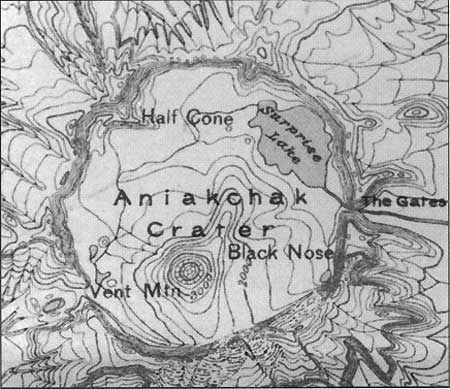
|
| U.S. Geological Survey, 1927, Reconnaissance topographic map of the Aniakchak District, Alaska, Scale 1:250,000, unnumbered. |
Another famous name Hubbard hoped to link with his own was the newspaper tycoon, William R. Hearst. The Glacier Priest confidently believed that Hearst would sponsor him with $25,000 in equipment "for merely the privilege of publishing my scientific findings." [18] When no windfalls from Hearst materialized, Hubbard arranged his transportation directly with the Alaska Packers Association, which operated a cannery in Chignik and maintained fish traps in Aniakchak Bay. According to Price, this was the beginning of a mutually beneficial arrangement between Hubbard and the Alaska Packers Association. While Hubbard secured transportation and field support from the fish canners, in return, Alaska Packers acquired Hubbard's Glacier Priest persona as a voice of support for its commercial enterprises in Alaska. In his 1935 account of his Alaska travels, Cradle of the Storms, Hubbard devoted an entire chapter entitled "Salmon" to the fishing industry. During the statehood debates, the priest spent time lobbying in Washington D.C. on the powerful salmon packers' behalf. Hubbard even made a documentary about the canned salmon industry called Alaska's Silver Millions, which highlighted the fish canners economic contribution to the northern territory. The commercial-ridden film integrated scenes of Aniakchak Caldera with images of a mechanized, modern salmon cannery. While narrating the film, Hubbard claimed:
The Bureau of Fisheries was wisely established in 1924 to study the question [of salmon conservation] thoroughly and to use the necessary means to preserve this great national asset. Most people do not realize how valuable this asset is. Secretary of State Seward, when he purchased Alaska in 1867 from Russia, paid $7,200,000 for it, in spite of much uniform criticism—such as has lasted even to this day—to the effect that Alaska is an icebox only fit for Eskimos in igloos. Even if this ungrounded criticism were true, even if the whole territory of Alaska—instead of being a magnificently forested land full of minerals and agricultural wealth—were actually only an ice cap, it would have been worth its purchase price for the value of its adjacent waters alone. [19]
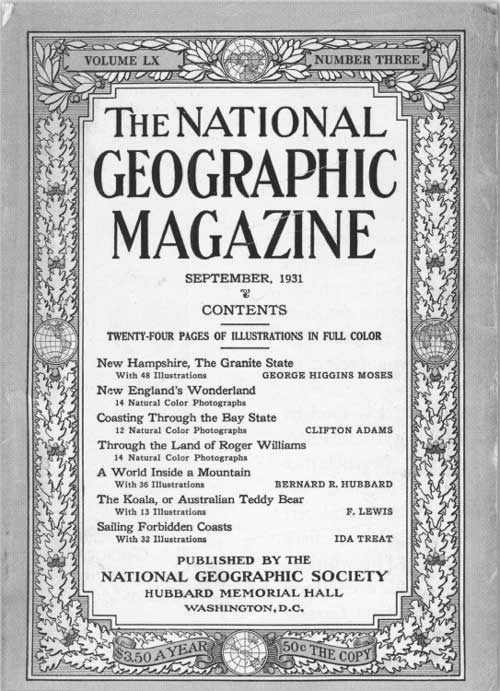
|
| National Geographic Magazine, "A World Inside a Mountain," September, 1931. |
With a deal made and agreements struck, on a sunny June day in 1930, an Alaska Packers tender dropped off the explorers and their gear onto a beach at the mouth of the Aniakchak River. Quickly the quartet loaded their equipment, weighing a total of 1,020 pounds, onto a fifteen-foot-open boat, powered only by a much-overextended outboard motor, and began the slow chug up the Aniakchak River. As the Santa Clarans ascended, the river became much more crooked and gray with ash. They noted salmon swimming up river to their spawning grounds and gulls and eagles soaring overhead, waiting for their moment to catch dinner. While moving further inland, Hubbard began to notice the strange beauty of the volcanic landscape:
Presently we were bucking rapids, struggling on a crest of whitecaps between canyon walls of ash pumice and honeycombed lava. These strange pallid gorges were more than 100 feet deep and shut out every surge of vegetable and animal life. Low in their walls were tunnels through which subterranean steams poured into the river. [20]
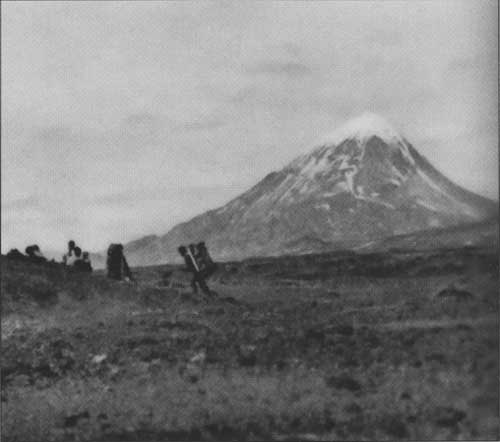
|
| Trek into the Caldera, 1930. National Geographic Magazine, "A World Inside a Mountain," September, 1931. |
For two days, the explorers chugged their way up the river. At the junction of the Aniakchak River and Albert Johnson Creek, about halfway to the crater, the boat could no longer navigate the winding rapids. There, the team drew out the boat; spent the night along the edge of the river; and set out with one-hundred-pound packs the next morning on foot. As they trekked up the foothills flanking Aniakchak, the men observed the grand beauty of the surrounding countryside, highlighted by the triangular-shaped Pinnacle Mountain. They tramped through meadow after meadow of wildflowers, and were surprised by the region's active wildlife. The men saw numerous ptarmigan and grouse, foxes trotted along their path, while marmots whistled as they went by. "We were in an Eden," recalled Hubbard, "inhabited by birds, nesting water fowl, and the tamest wild animals." [21] At a creek Hubbard knew as Plenty Bear, the party encountered several brown bears fishing for salmon. Unfortunately, these bears were not as tame as the wild critters the team had met previously. "On the night before we reached the crater," Hubbard explained, "a big bull bear charged our tent and I was forced to shoot him." [22]
For three days, the men hiked towards the crater, growing weary under the weight of heavy packs. Then, as they neared a large gouge in the crater wall, the Gates of Aniakchak, the party was struck by the first major storm of the trip. In Hubbard's words, "a heavy wind had risen, and peculiar, disk-shaped clouds came rolling in from the Bering Sea." [23] Although they set up their tent in the lee of the winds, they still had to pile rocks around its edges to keep it from blowing away. The following morning, Hubbard, Chisholm and Bartlett followed the tracks of a mother bear and cub through the Gates and entered the Caldera for the first time. Although the winds had ceased outside, the three men found a terrific storm raging inside the walls of the crater. Hubbard likened the Caldera to a "caldron of boiling clouds." [24] Describing this phenomena, he noted, "A dark, lowering mass of clouds covered something immediately in front of us. Cloud Niagara's flowed over the 3,000-foot rim to fill the floor of the crater, while the wind tore the vapor billows to pieces and sent them hurtling across the crater floor to swoop up to the rim on the farther side, more than six miles away." [25] Forced to turn back, the three men reluctantly returned to their tent until the next day.
The following morning proved to be a much better day. The party woke to sunny skies and hurriedly packed their gear. They entered the Caldera for the second time and immediately viewed its most prominent feature. Climbing a six hundred-foot cliff near the Gates to obtain a wider outlook, Hubbard and his party observed for the first time the majestic snow-covered Vent Mountain, "a volcano," Hubbard noted with awe, "within a volcano!" Volcanic ejecta washed from Vent Mountain's slopes formed a long alluvial fan, which Hubbard suggested "resembled a giant spider web lying in wait for prey." They then noticed that reflected in the calm waters of a two-and-a-half-mile lake was a mirror image of Vent Mountain. According to Hubbard, this lake, known today as Surprise Lake, "looked as if a child had colored it." Half the lake was a deep robin's egg blue with crimson shores and the other half was bright orange with yellow shores. They confirmed that Surprise Lake was the headwater of the Aniakchak River. In its escape, the lake water flowed past two cinder cones, one four hundred feet high and the second eight hundred feet high, and then made a mad dash through the Gates on its journey out to sea. [26] That night the party camped at the head of Surprise Lake, where coves provided some shelter from any foreseeable storm.
For the next two weeks, Hubbard's party explored the world inside the Caldera. "We had expected to find nothing but sterile wastes inside the volcano" recalled Hubbard, "and the amount and variety of life astonished us." [27] The party encountered numerous songbirds, eagles, ravens, ducks, seagulls, salmon, foxes, rabbits, and bears. Hubbard was especially impressed by the variety of flowers, particularly the local orchids that grew in the gullies near Surprise Lake. Besides wildlife, Hubbard and his companions were amazed by the geological features encased in Aniakchak. The party scaled and studied Vent Mountain; they photographed a wall of volcanic glass; and they even discovered fossils embedded in the sedimentary strata of a distinct feature known as Black Nose.
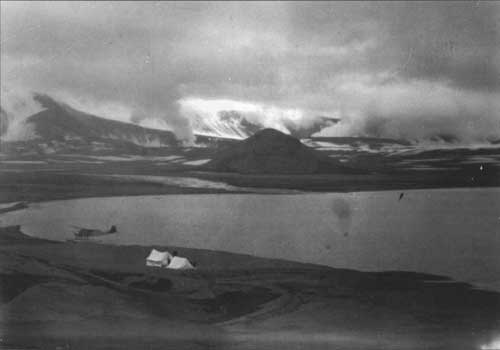
|
| "Airplane and camp in the crater of an active volcano" Bernard Hubbard, S.J., Alaskan Photograph Collection. Photograph courtesy of Santa Clara University Archives. ACK-00-121. |
Still, their most important discovery by far came when the explorers noticed that in a multicolored crescent sub-crater, Aniakchak puffed out fumes of super-heated steam. Apparently the floor, between the high ridges of lava, was dotted with fumaroles. The formations were brilliantly incrusted with crimson, orange, and blue and smelled strongly of sulfur. "Naturally we were enthusiastic over our latest find, recalled Hubbard. [28] "Joyful over this wonderful discovery, we ran forward shouting at the top of our lungs: She's Active! She's Alive!" [29]
During the winter of 1930-1931, Hubbard began to bring Aniakchak into the public spotlight. National exposure of the 1930 summer exploration included articles in the Saturday Evening Post and the New York Times. Hubbard even prepared an article for the National Geographic Magazine, which included numerous photographs he had taken inside the crater. Meanwhile, he planned an ambitious itinerary to the Interior Alaska missions, to begin in January 1931, and a return to Aniakchak in early June of that year. Nearing the time of departure, Hubbard dramatically predicted to the Associated Press that an eruption in the Aleutians was imminent. Accordingly, the Seattle Post Intelligencer carried his announcement on the front page. [30]
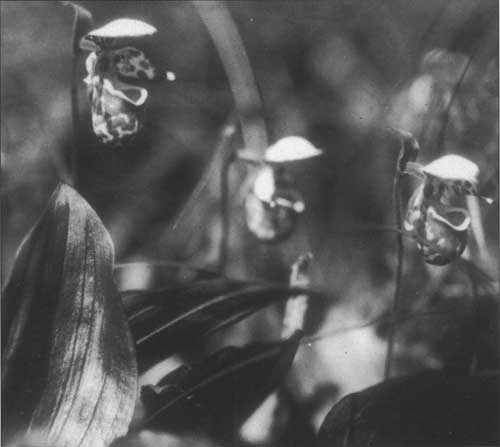
|
| Orchids in Aniakchak before the 193 eruption. Bernard Hubbard, S.J., Alaskan Photograph Collection. Photograph courtesy of Santa Clara University Archives. ACK-00-119. |
1931 Aniakchak Erupts
He predicted that Aniakchak was going to erupt, well, it hadn't erupted in 250 years, but if you can picture that volcanic rift, which is the Alaska Peninsula, it's a series of volcanoes, one into the other, and it was popping like a calliope, so I think Father Hubbard said, "It's got to be Aniakchak's turn."
—Bill Regan, interviewed by
Julie O'Keefe on February 8, 1985.
On Friday, December 19, 1930, the New York Times announced, "Father Hubbard Off Today on Trip to World's Largest Moon Crater in Alaska." According to the Times, the trek to the "land of perpetual ice and snow" would take Hubbard to a dozen isolated missions and finally to a "volcano crater inside of which he will live for two months." Hubbard's plan was, indeed, ambitious. "When the ice begins to break up next spring," reported the Times, "Father Hubbard will arrive at the Alaskan peninsula, where he will meet Professor R.A. Chisholm, former football star, and others, and a second expedition will begin to a region where 'geology is in the making.'" They will go to the "largest living crater in the world, the 'moon crater' of Aniakchak, and for two months will live inside this stupendous creation of rock, lava, glaciers, and hot mud." Hubbard explained to the press that he hoped to be repaid for the dangers and hardships his party will undoubtedly encounter by obtaining the "first complete record of the interesting scientific features of the crater so that a report may be made to the Federal Government at Washington." [31]
That winter, Hubbard took the Alaska Railroad to Nenana where he met up with Father Joseph F. McElmeels, S.J., and journeyed to Nulato by way of thirteen sled dogs. From Nulato, Hubbard traveled to the Bering Sea coast at Unalakleet, and then back to the Interior to Holy Cross mission, a small Yup'ik village perched along the banks of the Yukon River. By April, just after the Easter holidays, Hubbard reached his destination, having survived weeks on the trail with a strong-headed dog team, a race against the spring thaws, and even a bout with the flu. Still, thanks to nothing more than pure luck, Hubbard's most thrilling adventure was about to begin.
While Hubbard spent the spring sledding through Alaska's interior, his team of explorers left Seattle on May 9, 1931, en route to Chignik on the steamer Starr. Similar to the previous summer, the 1931 team consisted of very young students. Repeating his adventures with Father Hubbard was Ken Chisholm, Rod's brother, now a nineteen-year-old freshman at the University of San Francisco. The second was another nineteen year-old, a Santa Claran named William (Bill) Regan. Rounding out the exploration quartet was Richard (Dick) Douglas, of Georgetown University, who was also the great grandson of Steven A. Douglas, the famous Illinois senator. Douglas, who had previously been to Alaska on a hunting trip to Kodiak, had met Hubbard while the priest was on one of his lecture tours to the Georgetown campus. Impressed with the young man's knowledge of Alaska, Hubbard invited Douglas to join his Aniakchak team. The youngest members of the party, Chisholm and Regan, especially bonded on the trip. Years later Regan recalled, "We really became buddies, and we both had our nineteenth birthdays inside the volcano, which is kind of interesting." [32]
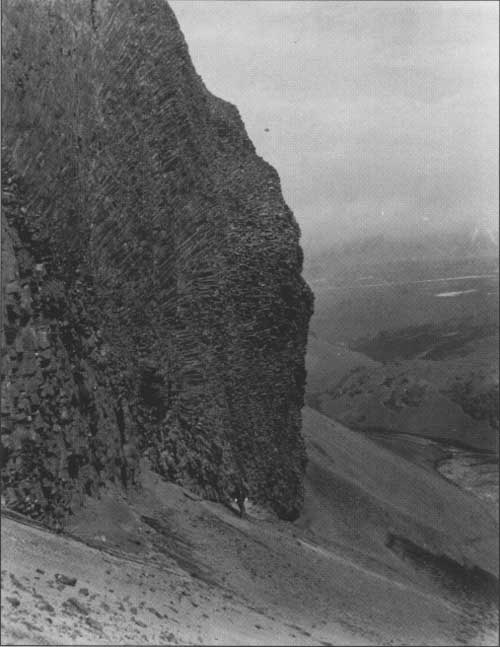
|
| Ancient lava flow in wall at Half Cone, 1931. Bernard Hubbard, S.J. Alaskan Photograph Collection. Photograph courtesy of Santa Clara University Archives. ACK-00-102. |
As the young adventurers sailed down the Alaska Peninsula coastline, they began to notice that the mountains looked very gray—even for early May. "I strained my eyes," recalled Dick Douglas. "A glacier that filled a cleft between two peaks looked almost black. In another half hour we knew something was wrong. The light was fading, but even though the mountains were dim in the dusk, they should not have looked as black as they did. Then, as the Starr carried us farther down the Peninsula, we realized that the mountains were covered with ashes! Obviously, some volcano was in fresh eruption." [33]
When the Starr docked at the Alaska Packers cannery in Chignik on May 20, the party found out which volcano had blown. Indeed, on May 1, 1931, at 10 a.m., a dense column of steam had shot up from the Aniakchak volcano. This rose for two hours in billowing clouds, followed by a big blast at noon. A dense black cloud rose over 20,000 feet, spread out like a mushroom, and started to descend. The earth shook and from the central region, and there was a fiery display of lava bombs making trajectories. Lightning and thunder added to the clamor of incessant detonations from the volcano, accompanied by the crash of falling rocks. Then came light cinders, at first the size of peas and then larger. According to Captain Halveorsen, the APA cannery's superintendent, the fall of ash at Chignik, located forty-five miles south, southwest of Aniakchak, was reported to be a pound per hour for each square foot of land. At Ugashik the ashfall was heavier, and in the country between Kodiak and the head of Bristol Bay, a mantle of ash a quarter-inch-deep formed. Light ash fell in the interior of Alaska at a distance of three hundred miles. Showers of pisolitic mud balls fell like raindrops and buried the neighboring snow-covered country and the glaciers under a gray pall.
On May 2, 1931, the radio operator at Kanatak, ninety miles northeast of Aniakchak, reported ashfall there. On May 13, the ash from Aniakchak was more than a half-inch deep and very black, falling continuously at Squaw Harbor in Unga, approximately 140 miles southwest of Aniakchak. The ash that fell at such great distances was fine as flour.
Eruptions continued until May 11, when a large blast made it pitch dark for several hours at distances sixty miles away. On May 12, a freighter at sea off the Aleutian Islands received a fall of sand during a storm. On Bristol Bay, located north of the volcano, witnesses reported a field of floating pumice five miles in diameter. Dense clouds of gas and smoke continued to rise from the central peninsula. Then, on May 20, another eruption caused an explosion that was heard two hundred miles away. For several days more, the Ugashik cannery, fifty-three miles north, northeast from Aniakchak, reported rumbling like distant surf. [34]
Shocked and in disbelief with the eruption of Aniakchak, Douglas recalled, "Our summer plans were probably completely 'shot'!" [35] Hubbard, on the other hand, had telegraphed his waiting companions. His message stated a more optimistic and ambitious plan for the summer:
HURRAH FOR ANIAKCHAK STOP
WE WILL SEE WHAT IS INSIDE STOP
WILL JOIN YOU WHEN ICE BREAKS ON YUKON STOP
WAIT FOR ME. [36]
The First Recorded Flight Down the Alaska Peninsula
On June 2, 1931, Harry Blunt, chief pilot of the Pacific International Airways, his co-pilot, Al Monson, and Father Hubbard left Holy Cross on a historic floatplane flight to Chignik [37] Although pilots like Russell Merrill and Ben Eielson pioneered air travel across Alaska in the 1920s, none had flown farther southwest than Kodiak. [38] According to Hubbard, not only was this his first airplane ride, but this was also the first flight ever made along the Bering Sea. "I will never forget that second of June, 1931," wrote Hubbard. "To be perfectly candid—I was scared half to death!" [39]
By 1931, airplanes were a significant form of transportation in Alaska. Ever since James V. Martin flew a Gage-Martin tractor biplane for a few minutes over Fairbanks in 1913, the airplane has proven to be uniquely suited to the northern environment. Pioneering pilots like Blunt found their niche hauling freight and people to the hundreds of islands and roadless communities that dotted the region. While docked for a short time in Seward that summer, Hubbard's companion, Dick Douglas, observed just how "air minded" Alaska had become:
Planes come and go, hopping off for Fairbanks, Nome, the Yukon or anywhere the traveler may wish to go. In Alaska, a trip over mountains that would cause most fliers to hesitate, with hardly any landing fields and with fog that rolls over the peaks without warning, is just another flight and nothing unusual. Nowhere, I believe, does air travel mean more of a saving in time and effort than in Alaska. A white mid-winter trial, with its miles of lonely mushing over snow and ice, stretching into weeks of hardship, becomes a six-hour journey in swift planes that take off after gliding over the snow on skis. In summer pontoons take the place of skis and the planes land on the lakes and rivers that dot and streak the territory.
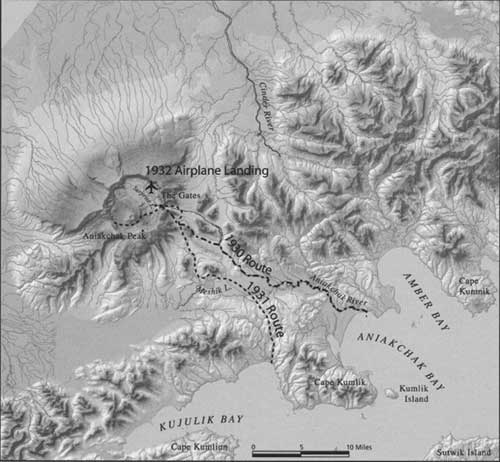
|
| Hubbard's 1930, 1931, and 1932 visits to Aniakchak. By B. Bundy. (click on image for a PDF version) |
On this particular historic flight, the crew and their famous passenger sped down the Yukon River, headed over the divide to the Valley of the Kuskokwim, and then made their way towards the Bering Sea. They skirted the capes and headlands of the rugged shoreline, passed over the reindeer herds grazing near Togiak Bay, and refueled in Dillingham. As they crossed Bristol Bay, weather became so thick that they had to land in Ugashik Bay. Weather again forced them down in a lagoon, and while Blunt and Hubbard slept in a lone trapper's cabin, Monson spent an all-night vigil protecting the plane from harsh winds. The next day, Blunt decided to drop off some of the heavier gear at the village of Port Heiden to ensure safe passage over the mountains to Chignik. It was there that Hubbard settled on his plan for exploring the erupting volcano: "I was convinced that an airplane could land on the bottom of the crater floor," he declared. "[I] expected to make the first landing of a plane inside an erupting volcano a climax to my year's exploration." [40]
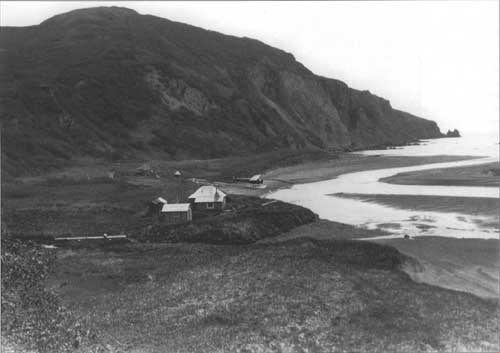
|
| Hubbard's base camp at Kujulik Bay, 1931. Bernard Hubbard, S.J. Alaskan Photograph Collection. Photograph courtesy of Santa Clara University Archives. ACK-00-141. |
Exploring Aniakchak: From Above and Below
The original plan was for Harry Blunt and Al Monson to fly the entire crew and their gear into the crater by landing on Surprise Lake. On a sunny June 10, Douglas, Regan and Chisholm departed Chignik on the cannery tender Dora, bringing with them the gear and food. They made a trapper's cabin, situated along the North Fork River in Kujulik Bay, their headquarters where they would await Father Hubbard and the pilots, and begin their adventures into the erupting volcano. The cabin in which they waited belonged either to Alec Brandal or Frank Grunert, both of whom had trapped in the region for years. Meanwhile, Hubbard took off on the plane with Blunt and Monson to film Aniakchak from the air, and to survey a good site to land later with the equipment. [41]
Once in the air, the plane headed directly towards the Aniakchak Crater. According to Hubbard, the countryside appeared more desolate as the crater, looming black in the distance, neared. As the plane roared into the Aniakchak River Canyon and toward the rift in the rim, the pilots and passenger alike began to note the intensive odor of sulfuric gases. As they climbed directly above Black Nose, the highest point of the rim, the crater opened up before them. Hubbard described the fiery scene:
The awfulness of the sight stunned me. It was the most terrible prelude of hell I could ever imagine. Last year it was a plant, fish, and animal world inside of a mountain where color and variety abounded, in the thirty-square-mile area closed in by 3,000-foot walls. Now it was the abomination of desolation with everything blotted out. Glaciers and snowfields all around the twenty-one-mile rim were black. Vent Mountain rising in the crater's center opened up its top like a huge black maw to swallow us. Steaming bulges, and cracks and hills of lava covered the southern area of the crater floor and a huge three-mile-circumference hole was blown out of the side. From it were curling brown gases, and a bluish haze, indicative of tremendous temperature, rose into the air. This last great pit was the cause of all our trouble and nearly proved our undoing. [42]
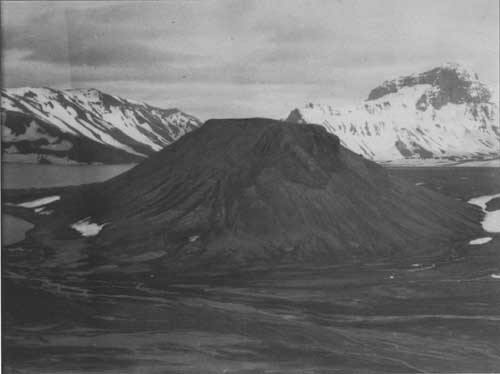
|
| Bolshoi Dome from Vulcan Dome, Black Nose is in the background, ca. 1930. Bernard Hubbard, S.J. Alaskan Photograph Collection. Photograph courtesy of Santa Clara University Archives. ACK-00-147. |
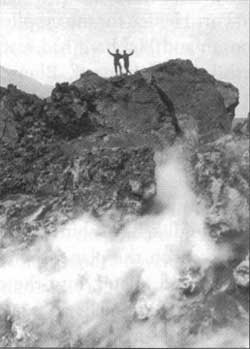
|
| "Dancing the Devil's Mazurka," Alaska Odyssey. |
As they flew over the erupting crater, the plane became caught in a down draft. Hubbard suddenly realized that the volcano was pulling the plane into the steaming crater. Instead of struggling against the force of gravity, to regain air speed, a quick-thinking Blunt drove straight down towards the crater and was able to right the plane. As quickly as they entered the crater, the plane exited through the Gates. Hubbard later remarked, "Aniakchak was not yet fit for aerial exploration....It was not to have been the climax." [43]
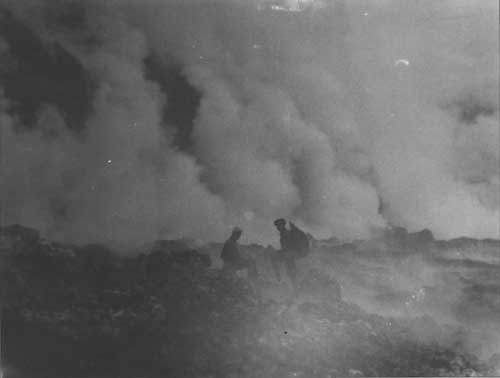
|
| At the bottom of the 1931 pit, ca. 1932. Alaskan Photograph Collection. Bernard Hubbard, S.J. Photograph courtesy of Santa Clara University Archives. ACK-32-270. |
Blunt's narrow escape from the crater forced the group to abandon any hope of landing inside Aniakchak. A new plan was devised: Blunt would land the party on Meshik Lake, located only fifteen miles from the rim and then fly over to Port Heiden for the supplies cached there before he, Monson and Hubbard had reached Chignik. After the Meshik Lake drop-off, Blunt and Monson would return to Anchorage, to return in mid-July to pick up the explorers. This meant that the team, instead of flying into the volcano, would spend much time hauling gear to the crater on foot.
Bright and early on the morning of June 12, Father said Mass at the Kujulik Bay cabin. Then, while Blunt and Monson worked on the plane, the quartet loaded their packs and headed inland, into the coastal-barrier mountains on their first reconnaissance trip to the crater. The men proceeded towards the Aniakchak River valley, with sunshine pouring down upon them. "We soon wished that it would change to rain," explained Hubbard. "Every time our feet descended on the mossy tundra, clouds of volcanic ash rose up, filling our eyes and ears and throats, and making our hair like wire brushes." [44] Douglas had a difficult time navigating the grassy hummocks. "As I struck the moss, it gave way beneath my feet and I sank to my hips in the cold black muck beneath the green surface." [45]
Though Pinnacle Mountain still marked the way, the meadows of wildflowers had been replaced by fields of ash. Hubbard described the landscape as "more like a scene in the Great American Desert than an Alaskan landscape," but even so, the group encountered numerous ducks, ptarmigan, and herds of caribou along their route. They even spotted bear tracks crisscrossing the valley floor. "We saw seventeen Kodiak bear, and lots of caribou and we killed them and ducks," remembered Regan. "We had permission to live off the land, kill any animals or birds that we saw." [46] They decided to set up camp, which they named Caribou Camp, in honor of the animal Ken shot for dinner that night. They were a day's journey from the crater rim.
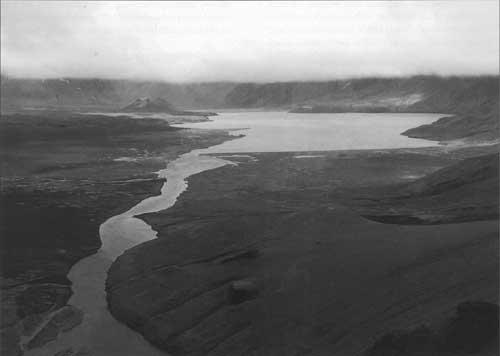
|
| Surprise Lake, Courtesy of the Southwest Alaska Network, National Park Service. |
The next day, after several hours of hard work, the party made it to the crater's edge. They ascended under the shadow of Black Nose, a feature that thrusts its dark shape higher the any point on the rim. Looking upon Aniakchak for the first time, Douglas noted, "Near the center of the crater floor rose Vent Mountain. . .there was a huge crack down its side where the mountain had torn itself nearly in two [and] where the earth had shook and moved a month before. But it was not Vent Mountain that had darkened the sky all along the Alaska Peninsula and rained ashes two hundred miles away. . .the cause of the destruction was far away, nearly five miles from us across the crater floor. There near the rim was a new pit, two miles wide, spitting up columns of white smoke and steam." [47] According to Hubbard, "There was the new Aniakchak, but [it] was the abominations of desolation, it was the prelude of hell." [48] That night the party made their way back to Caribou Camp. The next morning in a "southeaster" rainstorm, they began the trek back to Kujulik Bay to collect the heavier equipment. They then returned to the crater for what Hubbard described as a more "thorough exploration of the inside of Aniakchak." [49]
On June 16, Blunt and Monson flew Chisholm to Meshik Lake with the gear. The weather, however, turned stormy, and Hubbard, Regan and Douglas were forced to wait it out for several days at Kujulik. With the weather only worsening, the stragglers were forced to hike to their Meshik Lake base, eighteen miles away, where Chisholm had pitched camp. On June 21, the first day of summer and the longest day of the year, the three men followed a trapper's winter trail leading from the cabin, as rain pounded down upon them. Instead of following the route of their first trip, they headed farther west, where a long, tundra-covered plateau led the way towards Meshik Lake.
Meshik Lake is considered a divide lake. Johnson Creek flows from one end of the lake, joins the Aniakchak River, and empties into the Pacific Ocean. From the other end of the lake, Meshik River descends a long tundra slope until it reaches the Bering Sea. The lake is fed by steams from Pinnacle and Wedge mountains, two peaks rising four thousand feet from the valley floor. The lake lies close to the foot of the mountains, separated by a small stream. The stream, called Hidden Creek, crosses into flat tundra, which lies at the foot of the ridges that run up the volcano's rim. "The lake itself is very blue and will be a fine place to land the plane," recalled Regan. [50] Each man felt that this was an excellent spot for their new headquarters.

|
| Returning from historic flight into the Aniakchak Crater, from left to right: Father Hubbard, Ken Chisholm, Peterson, Rod Chisholm, Levin, Father Galtes, 1932. Bernard Hubbard, S.J. Alaskan Photograph Collection. Photograph courtesy of Santa Clara University Archives. ACK-35-263. |
When Hubbard, Douglas and Regan arrived to the Meshik Lake camp, Chisholm filled them in on his experiences over the past few days. Not only did he kill three bears in four shots—"a plenty good record," according to Regan—but he also managed to burn "the roof off" a Native ha ra ha ra. [51] As Douglas retells it, Chisholm had pitched the tent near the small dwelling made from alder polls and blocks of sod. According to Douglas, "The hut had been abandoned for the summer by its trapper owner. The stove made the barabara more comfortable in the dreary weather than his drafty tent, so Ken slept in the barabara." Apparently, Chisholm had fallen asleep during the afternoon, forgetting the fire in the stove. He awoke to find one wall blazing and the roof on fire. Although the party did not repair the barabara, they did leave the trapper their tent and quantity of supplies. [52]
The next day, the party loaded their backboards with movie cameras, several thousand feet of film, still cameras, film packs, tent, dehydrated food, and a change of clothes. As Regan recalled, "We had to carry everything with us. We had Father's Mass kit, we had our photographic equipment and our cameras, we had our guns, and we had powder eggs, powder vegetables, powder soup, dehydrated things." [53] Chisholm even carried a five-gallon can of fuel, for the men believed there would be no wood in the crater.
They hiked all day and set up camp near the Gates and then returned to Meshik Lake to retrieve the rest of their gear. On the morning of June 26, Chisholm, Regan and Douglas hiked back to Kujulik Bay to get the specimen box and camera they had accidentally forgotten in Chignik, and made arrangements for the cannery tender to drop them off at the cabin there. Reaching the cabin, the tired men realized that the cannery had not received their message, and hiked the long eighteen miles back to Meshik empty-handed.
The next morning, the party set out for a week in the crater. Along the way, the men, to their surprise, encountered wildlife near the still steaming crater. They were amused by the antics of several ptarmigan chicks and were startled by the presence of two big brown bears digging in the hillside for ground squirrels. One apparently charged the party, and was shot for dinner that night. By nightfall, they had reached their camp near the Gates and the next morning entered the Caldera. As the sun finally completed its long descent that evening, Regan recorded in his diary a description of a peaceful landscape: "The moon was full tonight and was the most beautiful I have ever seen. The ash in the air made it appear to be solid gold; and as it rose above the peaks and clouds in the east, it made a golden path across the lake." [54] But, once again, bad weather moved in and kept the explorers in camp for three long and grueling days. On the morning of June 30, the men picked their way along the riverbank through the Gates and finally entered the crater. Once inside, the explorers recognized little of the "geological paradise" they discovered the previous summer. Rather, the crater's desolation was as Hubbard described, "Paradise Lost." [55]
"It was like a dream of walking on the moon," recalled Douglas. "Over little mounds of moist black ash, across short stretches of dry gray dust, over small ridges and pits where bits of hot lava had fallen with the ash and burned their way into the snow; with not a sound but the crunch of our feet on the snow beneath the ash." [56] Hubbard especially noted the change from last summer: "Where streams that teemed with spawning salmon had wound to Surprise Lake, where flower-strewn meadows had smiled, where birds and beasts had found food and sanctuary, and pleasant coves along the lake had made inviting camp sites—now all was blotted out in one mighty cataclysm." [57]
With clearing skies above, Hubbard and his crew investigated the volcanic world. One of the first things they noticed was a mass of broken rock that had shaken loose from the stratified cliffs near the Gates. Imbedded in the rocks were fossilized clam and oyster shells, evidence of a time when the central Alaska Peninsula was covered by the Pacific Ocean. Over millions of years, the same subducting forces that created the Aniakchak Volcano had lifted the layers of hardened sea floor, turning it into limestone as it rose, and capturing the ancient sea life in stone for centuries to come. Fossilized animals, however, were not the only evidence of unexpected life in the crater. According to Hubbard, the team unexpectedly observed three more brown bear. According to Bill Regan, "the entire interior of the crater is cobwebbed with them [bear tracks]." When Regan rhetorically asked "What in the world is a bear doing up here?" Hubbard did his best to answer, "It is a surprise to me, but I suppose that bears are curious too, and he wanted to see what Aniakchak was doing." [58]
Leaving the rocks and the bears behind, the explorers chose a path that led to Surprise Lake, which followed the lakeshore all the way to its headwaters. Near the two cinder cones that had been built by much older eruptions, the team discovered a sulfur spring. At the confluence where the mineral-rich spring entered Surprise Lake, the waters were invitingly warm. Without giving it a second thought, the men, especially the more youthful members of the party, decided to strip off their dirty clothes and plunge in. Dick Douglas fondly recalls the swim as one of the finest experiences in the crater: "[We] rejoiced in our first warm bath in a month." [59]
Fun and refreshment, however, were not what Father Hubbard came to the crater to find. The Glacier Priest wanted to observe the source of the summer's eruption. Thus, it was on July 1, that the explorers reached the climax of their trip—"when we looked into the new smoking crater for the first time." [60] That morning the party set out on a route that made a half circumference of the crater around Vent Mountain. There they found two explosive pits, or what Regan described as "gashes" in the side of Vent Mountain. [61] Lava flows surrounding the pits formed strange shapes, which the men called "Aniakchak's circus." [62] Upon the slopes of Vent Mountain they found their first fumarole. From there they could see the source of the May eruption, nearly three miles away.
With a closer look, it became clear that approaching the explosive crater would be hazardous at best. The eleven-day series of eruptions in May had built a high black wall around the mile-wide pit, which steamed furiously with hundreds of vents and fumaroles. What was marked as a small glacial river on the map, failed to appear at the site; apparently the eruption covered it in several feet of ash. As the team approached the black steaming wall, a blue gas rose into the air accompanied by a great wave of heat. When the men caught the burnt smell of carbon, they scrambled to their feet and tried to run away from the crater. A cloud of carbon dioxide, however, brought them to their knees. Spots blurred their vision and the desire to sleep stole over them. Then, in a moment of good fortune, it began to rain. With the torrents came wind, which cleared the air of the carbon dioxide.
The air that morning was reported "chilly" and luckily for them, rain clouds coming from the Bering Sea poured upon them for most of the day. But, as their strength returned, the rain slackened. Relieved at first, the men began to notice that their clothes dried very quickly—a bit too quickly. As they moved closer to the activities in the large pit, Bill Regan exclaimed, "Hey, what are we getting into? These ashes are hot!" [63] With extreme caution, the men gingerly approached the edge of the still steaming hole. "We gasped!" recalled Douglas:
Colors—green and yellows and reds that took our breath away! The bottom of the pit was scarcely a hundred feet below us, a gigantic plug of red lava, in tumbled, broken blocks. Around the edge of the plug yellow masses of sulfur boiled and seethed, sending up gases too heavy to rise to the top of the pit; but swirling about over the lava plug like the surf on a coral reef. [64]
The men stood at the edge of the crater for some time. They filmed the explosive pit, but the black and white images could not capture the ongoing drama inside the crater, which Regan described as "a big slag heap of steaming lava, colored red, yellow, green, and brown." [65] Remaining at the pit for as long as possible, at dusk the party victoriously returned to their camp.
After a well-deserved day of rest, the men returned to the crater on July 3rd. As they approached the explosive pit, they encountered a second eruptive pit, almost as large as the crater discovered the previous day. On the day before the 4th of July, Regan realized that they were witnessing Aniakchak's own private fireworks display:
They called me the "chief chemist," only because I'd just finished taking chemistry from Father Duffy....Here we did make one little mishap. . . We first climbed to the top [of the black wall], it [the steaming pit] was still erupting and we were, obviously..., in it, and we look down and here were these upward coming "greaaat" clouds of purple, brilliant purple gas, and then pretty soon up came a kind of gray-green, and then a bronze and then a brown and I announced pontifically to my associates that we were looking at the halogen family, and interestingly enough, it was the halogen family: chlorine, bromine, fluoride, and iodine.
On July 4, the explorers slept soundly until 11 am, rose to a hardy breakfast, and prepared their packs for the long journey back to their Meshik base camp, where they were to meet pilot Harry Blunt the next day. After a frustrating trek through Aniakchak's quick-growing summer vegetation, the men made it to camp at Meshik Lake on time, but Blunt was nowhere to be found. When July 7th went by without sign of the aviator, the men began to worry that something terrible had happened. As food supplies grew slim, the quartet not only grew anxious, but hungry as well. Douglas recalled:
First we tried the ducks.... [But] they had suddenly acquired a liking for the middle of the lake...We tried in vain to hit the tiny snipe that whistled above the marsh...Every ptarmigan apparently had vanished. Not a single fish would notice our hooks set in the lake. So we ate beans for breakfast and rice for supper; rice for breakfast and beans for supper. [66]
By July 8th, the men began to feel desperate. The lack of food and no sign of the plane were minor considerations compared to the torment that attacked them at night. At sunset, millions of mosquitoes moved into camp and forced each six-foot-sized man to retreat into the small rent. Douglas remembers the horrible sound of buzzing at night:
The persistent hum of the mosquitoes bothered me more than the bites. To hear a tiny buzzing in the darkness a few inches from your ear, rising to a higher pitch and suddenly ceasing, while you lie still and wonder where you will feel the sting of the mosquito that has lit somewhere on you, is enough to try anyone's patience. [67]
On July 10, just as the hungry crew felled their first caribou in weeks, they heard a more welcome buzz—the roar of the plane's engine landing on the lake. Blunt brought with him a new companion, a young man named Jinx Ames, who served as the flight's mechanic. Blunt also brought the explorers a box filled with lettuce, cantaloupe, and homemade bread. That night, Father Hubbard, Regan, Douglas, and Chisholm feasted on bread, lettuce, and their first fruit in weeks, while Blunt and Ames enjoyed the caribou steaks.
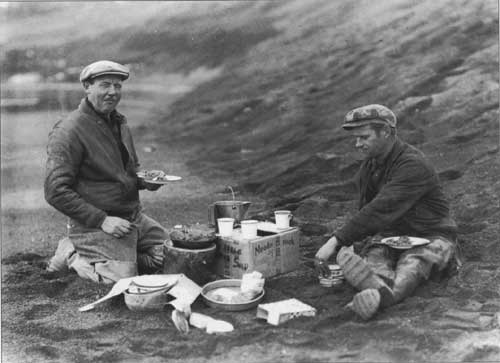
|
| Frank Dorbrandt and Larson have lunch at the north shore camp site on Surprise Lake. Note the 1931 tephra is underfoot, 1932. Bernard Hubbard, S.J. Alaskan Photograph Collection. Photograph courtesy of Santa Clara University Archives. ACK-00-41. |
Discussions over dinner revealed that the party's lost equipment arrived a day after they had made the useless thirty-five mile hike to Kujulik Bay and back. There was no other choice but to make the trek once again. The next morning Father Hubbard and Dick Douglas set out for the cabin at Kujulik, while Chisholm, Regan and the aviators flew to Chignik for extra supplies for one last trek into the Aniakchak crater.
On July 10th, the group reassembled at Meshik. Although his knees were bad, Blunt decided that he wanted to join the explorers. The extra backs were a welcome addition to the weary explorers. So with Blunt and Ames tagging along, the group set out over the snowfields above Hidden Creek and followed the Aniakchak River to their campsite near the Gates. On July 11th, the party made their final trip to the pit inside the Aniakchak Crater. One their way towards the built-up crater, the men first took time to climb an ash-covered hillside, and noted that beneath it, lava, accompanied by gas-laden steam, was being pushed up from the depths below. Douglas compared the escaping gases to buckets of colorful paint that "relieve Aniakchak of her blackness after the first rain of ashes." [68] The party tried to take the temperature of one of the smaller fumaroles with one of their Carnegie thermometers. In three minutes, the thermometer burst at 200 degrees centigrade. After another gaseous cloud full of chlorine briefly showered them, the party made their way toward the crater. "This was Aniakchak," recalled Douglas, "this was its terrible, mighty heart." [69]
The final trip into the Aniakchak crater seemed to be almost too much for the men. They were tired when they reached their Gates camp site that evening, but instead of resting for the long journey ahead, at nine o'clock Father Hubbard asked his crew, "Who feels like walking back to Meshik tonight?" [70] With a hesitant "Let's go!" the party extended their already long day, minus Blunt and Ames, who decided to stay at the Gate's camp and sleep. Loaded down with heavy packs, the men climbed through alder-filled gullies, were drenched by rain squalls, and consumed by shoulder-deep grasses. When they finally made it to Meshik Lake, they had been going for twenty-two consistent hours. "We were completely exhausted when we arrived at camp in broad daylight at three o'clock [a.m.]," recalled Regan. Apparently, Father Hubbard was almost "hysterical from fatigue" and for the first time all year, missed saying Mass. [71]
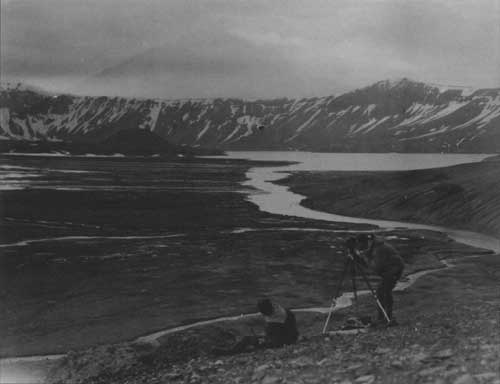
|
| Hubbard filming from terrace on south side of the Gates, ca. 1932. Bernard Hubbard, S.J. Alaskan Photograph Collection. Photograph courtesy of Santa Clara University Archives. ACK-32-278. |
The next day, Blunt and Ames arrived at camp, and in the afternoon, flew Regan, Douglas and the equipment back to Chignik. As the plane took off, it made a few circles around Meshik Lake, giving the tired passengers a final look at Pinnacle and Wedge mountains. As they ascended into the fog, only the black walls of Aniakchak loomed above them. "From the center of the black circle arose a tall pillar of steam," recalled Douglas, "Aniakchak was bidding us goodbye." [72]
During their thirty-three days of exploring Aniakchak, Hubbard and his young companions hiked 350 miles of tough country—235 were under heavy packs and for the remainder they carried burdensome photographic equipment. Along the way the saw and observed many things. They saw nineteen bears, seventeen caribou, and hundreds of ducks, ptarmigan, and grouse. They described, in great detail, the numerous geological features that exist within the Caldera, But without a doubt, the most lasting and impressive image was the active and eruptive crater. "There was our great moon crater," wrote Hubbard, describing his final gaze into the explosive pit, "active in its terrible anger, destructive in its fearful rage, inspiring in its terrible beauty." [73]
1932 "Flying the Lid of Hades"
Such evidence would tend to convince even the man from Missouri of the genuineness of our exploit.
Father Bernard Hubbard,
Cradle of the Storms
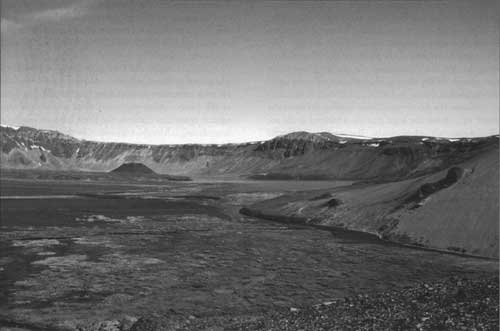
|
| View from Hubbard's photo site, 1997. Photograph courtesy of Game McGimsey, USGS, Anchorage, Alaska. |
In the summer of 1932, Father Hubbard made one last historic trip into the Aniakchak crater. The Glacier Priest, his old friend, Rod Chisholm, Ken Chisholm, and new assistant, Jack Morton, had just climbed Shishaldin Volcano on Unimak Island. The team had assembled at the Harris Cannery at False Pass, and while telling stories of their adventures to the local cannery crew, a big red-haired pilot named Frank Dorbandt said, "Say, Pop, I'm going to land you in Aniakchak crater. Get your stuff and let's go!" [74]
Frank Dorbandt's reputation as a pilot was well known throughout the territory. Friends and fellow aviators described him as "one of the ablest of the pioneers" but he was also known as being "reckless and impulsive." According to NPS historian Sandra Faulkner, Dorbandt was best known for his association with Alaskan aviator Ben Eielsen. In 1929, he and Eielsen flew routes back and forth between Teller and Siberia. [75] Hubbard, who called Dorbandt the "noted daredevil Alaskan aviator," considered the pilot the perfect choice to make the first successful landing inside an active volcano.
In wind, rain, and clouds—typical weather for the Aleutians—Dorbandt, with Hubbard and mechanic, Herb Larison, took off from False Pass for Aniakchak. They approached the volcano from the Bering Sea side of the Peninsula. According to Hubbard, "The Bering Sea has a habit of forming compact, concentrated storms. It tightens them up like a coiled spring until all their fury is leashed, then throws them into space." Indeed, the Bering winds hurled the plane about, and at times, they were forced to an altitude of only twenty feet. Just as Hubbard was wondering if Dorbandt would have to land to wait out the storm, the pilot answered his thoughts: "Strap yourself in your seat," Dorbandt told his passenger. "It's going to be rough." [76]
Once out of the main storm, the plane "rocketed past" Port Moller, which, at the time was the only port within hundreds of miles. As they flew up the coast line of the central Alaska Peninsula, the subarctic sun shone overhead causing the myriad lakes and meandering streams of the Bering tundra to glisten below. Visibility was good around Veniaminov Volcano, second in size to Aniakchak and only sixty miles away. But as the plane neared the looming crater, they realized that Aniakchak was blanketed by clouds. Hubbard recalled that the Caldera "looked like a huge wash-tub filled with soapsuds running over and down its sides." [77] Unable to find a hole, they decided to wait it out at Meshik Village. The next day, however, the weather turned worse instead of better, A new gale blew in and lasted for two days. The storm bent the rudder of the plane and ripped part of the wing tip. But the damage was not disabling, and when the weather finally cleared, they started off once again for Aniakchak.
To test the air currents, Dorbandt flew far above the crater rim. From the high altitude, Hubbard could see all of Aniakchak in one glance. The inspiring and awful landscape brought back unsettling memories of his first attempt to land in the crater:
In such moments as these, of intense concentration, vivid impressions come quickly and in great number. We were right over the Pit of Hades, blown out of the crater just a year past almost to the day. Ominous clouds of steam and lethal gases still curled from its black, gaping depths. A glance showed the white cup of Vent Mountain, the rent in the crater walls called the Gate, and the lake tucked under the northern cliffs of the rim. All was as when I had last beheld it, save that the beautiful white shows of winter had covered the unsightly black pall of erupted ashes and restored to Aniakchak part of its one-time beauty.
After checking out the different directions of air circulating around the Caldera, Dorbandt chose his course of action. The pilot approached the crater at top speed, diving low inside the crater at 135 miles an hour. "With a thrill I realized that we were inside the volcano," exclaimed Hubbard, "and the plane was under perfect control." [78]
Once inside, Dorbandt measured the distance around the rim using his speedometer. The aviator calculated that the crater circumference was twenty-one miles and the length of Surprise Lake was two-and-a-half miles, In what amounted to a few minutes, the flight accomplished what had taken the U.S. Geological Survey a period of two years to explore and map. Then, in a stunt that revealed his daredevil showmanship rather than his need to pursue scientific knowledge, Dorbandt dove the plane into the explosive pit—the source of the 1931 eruption. Hubbard, with enthusiastic assent, wound up the spring of his camera and yelled, "Go to it!" [79] Although the plane buzzed harmlessly through the rising steam coming from the hole in the earth, the unpredictable air currents moving through the Gates nearly threw the plane into the precipitous cliffs. Turning back into the crater, Dorbandt aimed the plane towards Surprise Lake. With a simple bank and sideslip, the pontoons splashed into the water, making this the first successful landing inside an active volcano. Once on shore Dorbandt turned to Hubbard and stated, "Well, Pop, I told you I'd land you in Aniakchak." [80]
While Larison and Dorbandt ate lunch, Hubbard spent time gathering evidence of their historic landing. He took numerous pictures from various vantage points of the plane. After the pilots filled themselves with canned beans and crackers, the three men explored the surrounding landscape together. On their return, Dorbandt noticed that the gas gauge showed only about twenty minutes of gasoline left. Frowning, the pilot surmised that it would take thirty minutes to spiral out of the Caldera. After such a glorious achievement—landing a plane inside a volcano—Hubbard later commented that it would have been a humiliating climax to have had to remain there for a lack of gas. [81]
Without revealing his plan, the pilot ordered his passengers into the plane. Once in the air, Dorbandt headed straight for the opposite wall near the steam rising from the active pits. As the plane neared perilously close to the jagged rocks along the crater wall, Dorbandt found what he was looking for—an updraft. With a surge, the plane shot almost straight up a few hundred feet. When the gust of wind they rode died, Dorbandt turned again into the column of steam, which eventually blew the plane right out over the top of the crater, "The volcano itself had literally thrown us out," exclaimed Hubbard, "and we still had seventeen minutes of gasoline left." [82]
Father Bernard Hubbard: The Ansel Adams of Aniakchak?
According to geologists and biologists working in the field today, a significant contribution Hubbard made during his three popularized visits to Aniakchak is the numerous images of Aniakchak's geological and environmental features that he captured on film. Hubbard's observations, photographs and films of the volcanic landscape before and immediately after the 1931 eruption offer today's scientists an unparalleled opportunity to measure the adaptability of organisms and ecosystems as they existed in this dynamic and unstable environment. Although this study argues that Hubbard captured those images primarily to serve as a backdrop to his own Glacier Priest persona, today's scientists are looking beyond the foreground, and concentrating on the images behind the explorer.
Recently, NPS researchers have begun to study how the volcanic landscape of Aniakchak has contributed to the local adaptations of plants, fish, and fauna. To determine the rate of ecological succession that followed the 1931 eruption, these researchers are comparing Father Hubbard's photos with photographs of the same geological and biological features taken by Bureau of Land Management during a Wild Rivers Study, and similar photographs taken by NPS researchers during the 1972-1976 study of the Caldera. In the summer of 2001, park biologists spent a summer in Aniakchak retracing the steps of Hubbard and other past researchers to photograph the same features. By arranging each series of photographs into a chronological timeline, biologists hope to determine how the volcano has shaped this ecological world over time, and perhaps more impressive, how the ecological world has responded to such violent and cataclysmic events.
In the past seventy years, vegetation has made subtle changes—where orchids have disappeared, other plant species have returned and thrived. Snowfields have vanished, and the lakeshore has moved and changed. Most interesting to scientists are the adaptive differences of the sockeye salmon population that returned to the Aniakchak River almost immediately following the 1931 eruption. They have noted that the fish adapt as they move from sea, to the stream, to a lake inside a volcano—a vast array of habitats. Such studies will help NPS managers identify the role of geological events in creating species diversity and promote management actions that protect ecosystems and resources. Perhaps Hubbard never foresaw his data employed in such ways, but as an explorer-scientist, he would undoubtedly be pleased.
Still, in the end, Hubbard chose to spend his time in the Caldera filming volcanoes rather than fussing over scientific scrutiny and detail. This has made it very difficult for researchers to interpret and ultimately use the data he gathered to its full potential. According to Troy Hamon, who serves as Chief of Natural Resource Management and Research Katmai National Park and Preserve and Aniakchak National Monument and Preserve, "Most of Hubbard's research seems so poorly documented that we are unable to make inferences about what we see today in relation to what he saw." Unfortunately, too many of Hubbard's photographs are poorly documented as well. As Hamon points our, "We [NPS researchers] struggled in many cases to identify which year photos might have been taken." [83]
Perhaps Hubbard may not have maintained meticulous discipline, but as some scholars argue, he left his mark on Aniakchak as an artist and storyteller. Today, it is difficult to discuss Aniakchak without Hubbard's images and stories coming to mind. Though he exaggerated facts, exploited his own adventures and experiences for personal gain, and, at times, either ignored or exploited indigenous cultures when it was convenient to his narrative, Hubbard understood contemporary trends in Arctic exploration and publicity. For example, Hubbard's artistic tour de force, the 1933 commercial film Aniakchak, tied together the elements the public expected from an Alaskan picture—snow and ice, dogsleds, and traditional Eskimos—with his own volcanic interests and Glacier Priest persona. Although it was never profitable to its distributors at Fox Films, Aniakchak played in twenty-four countries everywhere from Europe to South America to Asia. [84] For the first time, Alaska and the Glacier Priest received international attention on the silver screen. Historian Kathy Price agrees, for she insists that the Glacier Priest's most significant contribution to Aniakchak was what he captured as photographer and filmmaker:
"I don't think his artistic skill as a photographer has been fully recognized," explains Price, "partly because he didn't portray himself as an artist but as an 'adventurer in the name of science.' But when you look at the literally thousands of things he left behind: letters, ephemera, books, articles, photos, etc, it is the visual images that strike you. Their power and immediacy still resonate, unlike the products of his quest for celebrity, which have become quaint or amusing after the passage of time. Maybe, if he'd been able to step away from his need to create and sustain the 'Hubbard Mystique,' his visual legacy would have been more apparent; it would not have been obscured by his drive for publicity and the controversies he generated. After all, this was hardly a man pursuing art for art's sake." [65]
Yet whatever his motivation was, Price points out that toward the end of his life, the Photographers Association of America recognized Hubbard for his contributions to photography as a medium, and placed the Glacier Priest in the same company as Ansel Adams, Margaret Bourke-White, and others. Ironically, instead of arctic explorer, geologist, or famed lecturer, Price suggests that Hubbard bequeathed his eye for artistry to Aniakchak. "If someone were to call him the unrecognized Ansel Adams of Aniakchak," offers Price, "I don't think I would argue with them." [86]
NOTES
1Norris, "Isolated Paradise," 424.
2Price, "Adventuring with the Glacier Priest," 46.
3The American Catholic Volume III, "Who's Who, 1938-1939" (Detroit: Walter Komp and Co., 1940), 198.
4New York Times "Priest Said Mass in Alaskan Crater," (November 16, 1930), 27.
6Norris, "Isolated Paradise," 412-413.
8Report Vladimir Modestov, Nushagak, to Dean of Clergy of the Unalaska District. Aleksandr Kedrovskii, 29 July 1895 (f393-401), Lake Clark Katmai Studies Center, Anchorage, Alaska.
9Hubbard titled his chapter on his visit to the 10,000 Smokes as "the Terrible Grandeur of Katmai," Mush You Malamutes, 69
10Willoughby, "Moon Craters" 10.
11Larry Rice, Gathering Paradise: Alaska Wilderness Journeys (Golden, CO: Fulcrum Publishing, 1990), 265; Joe L. Miller, personal communications, 3/15/2002.
12American Magazine, "Fire-Eater" (January, 1935), 35.
13Current Biography, 1943, "Hubbard, Bernard (Rosecrans) Father" 320-323.
14Literary Digest, "The Stand Out From the Crowd," (August 19, 1933), 11.
15Willoughby, "Moon Craters of Alaska", 10-11.
16New York Times, "Football Star in Party," (November 16, 1931), 27.
19Alaska's Silver Millions, circa, 1935.
23Hubbard, "A World Inside a Mountain," 323.
26Willoughby, 13; Hubbard, "World," 329-332.
30Seattle Post Intelligencer, "Alaska Volcanic Eruption Seen," January 30, 1931, 1.
31New York Times, "To Live Two Months in Active Volcano" December 19, 1930, 19.
32William Regan, interviewed by Julia O'Keefe, 8 Feb 1985, transcript of tape recording, Hubbard Collection, Michel Orradre Library, Santa Clara University, Santa Clara, California Interview, 2-3.
33Douglas, Land of Thunder Mountain, 15.
34"The Eruption of Aniakchak" The Volcano Letter, No. 375. Hawaiian Volcano Observatory, National Park, Hawaii, March 3, 1932, 2-3; Seattle Times 5/2/31 "Alaskan Volcano Eruption Almost Blankets Radio Kanatak station 100 miles north of Chignik"; Seattle Daily Times Sunday May 4th 1931 "Alaska Volcano still Erupting: Sky Obscured unidentified volcano, believed Aniakchak."
37Sandra M. Faulkner, "Father Hubbard, the Glacier Priest: Aviation in Alaska's Past" paper delivered at the Alaska Historical Society Symposium, Fairbanks, Alaska, October, 1987. l.
38Alaska Geographic, "Frontier Flight," (Volume 25, Number 4, 1998), 32-35.
41Regan's Diary, June 10, 1931, page 19, copy on file at the Lake Clark Katmai Studies Center, Anchorage, AK.
46Regan, interview by O'Keefe,
50Regan's Dairy, June 21, pg. 27.
54Regan's Diary, June 28, pg. 13-32.
60Regan's Diary, July 1, pg. 33.
65Regan's Diary, July 1, pg. 34.
83Troy Hamon, personal communication, 1/6/2006.
84Price, "Adventuring with the Glacier Priest," 69.
85Kathy Price, personal communication, 1/7/2006.
| <<< Previous | <<< Contents>>> | Next >>> |
hrs/chap8.htm
Last Updated: 03-Aug-2009